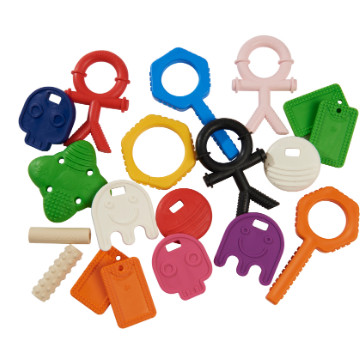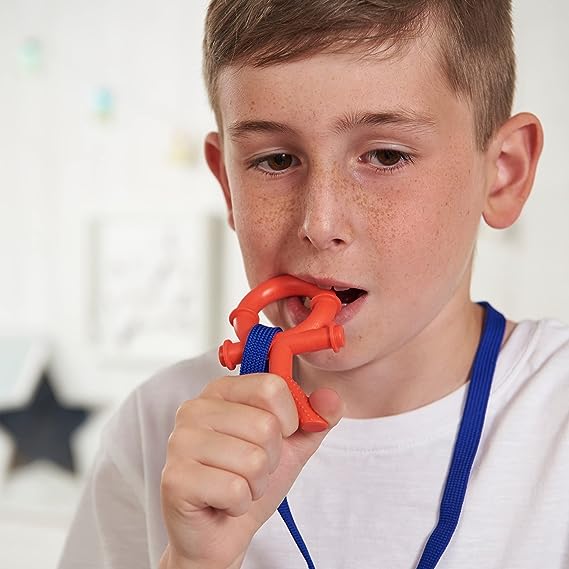Get exclusive deals you won't find anywhere else straight to your inbox.

#AsktheOT - What Are Sensory Chews
At Sensory Direct it's our job to help each and every customer get the product that's right for them.
Together with a network of Occupational Therapists and Professionals throughout the UK we aim to provide help, support and advice across a range of topics.
Each quarter we will team up with a series of OT's and likeminded Professionals to answer a series of questions across a variety of topics.
Why, we hear you say? Well, to put it simply, at Sensory Direct we aim to help people.
By providing professional support alongside our own personal experience and product knowledge, we can give the best support and advice to you.

For this edition of #AsktheOT we were delighted to work with Bryher Hill, from Helping Kids Shine.
We put Bryher to the test and asked her some of our most frequently asked questions all about
Sensory Chews.
Bryher says:
'As Occupational Therapists, we aim to complete a thorough, holistic assessment of a person’s needs.
If a person is chewing, or if their chewing has increased, this may be a sign of them finding things challenging in their day to day lives.
This may be at school or at home for example.
Having completed an assessment, we can then identify what changes could be made to their activities and environment.
We can also recommend direct therapy input if required, to support that person to manage their individual sensory needs.
Chewing generally provides proprioceptive input - proprioception is one of our 8 senses and is a little bit magical.
It can help us to feel calm if we feel overwhelmed and it can alert us if we are feeling under-stimulated.
The sensory input provided by chewing feels good.
Some people may choose certain food items to chew on. Others will choose various objects found in their environment.
This may be sleeves, collars of polo shirts, remote controls, drinks cans, etc.
Different people will find different things to chew that feel good for them.
We hope that this is a helpful overview of our thoughts on Sensory Chew.
Please note that these opinions are our own and we would recommend you consult with your own Occupational Therapist if you require any further guidance.
#1 What is the purpose of a sensory chew?
In our work we come across many children, young people, adolescents and adults who have an innate need to chew.
If a person is chewing on items that are unsafe and is at risk of ingesting pieces, or is causing damage to items they are chewing, sensory chews may be an option.
#2 Who can benefit from sensory chews?
Sensory chews can be trialled with anyone who likes or needs to chew.
Sensory chews are especially helpful for people who may have previously sought out chewing on toxic or dangerous items.
#3 How can I pick the best sensory chew for me or my child?
If possible, it is important to consider the properties of the things that you or the person likes to chew already.
Some people need a sensory chew that has a textured surface, whereas some need something that is soft or firmer.
You can then explore what options there are and try a few out to see which feel best. This is a bit of a trial and error process!
Ideally, you should find a sensory chew that provides the same sensory input as the item that they are already chewing on.
#4 What age can I give my child a sensory chew?
The first thing to say here is that the use of sensory chews must be supervised, especially with younger children.
There are some chews that are specifically made for younger children who are at a mouthing stage of development.
They may also be showing some hyper-reactivity (over-reactivity) to the sensations of things in their mouths.
When buying a sensory chew, always refer to the manufacturer’s guidelines as they may state minimum ages.
#5 How often should I replace my sensory chew?
You should replace a sensory chew at the first signs of damage or deterioration to the item.
Chews may lose some of their resistance over time.
Therefore, if you feel the sensory chew is not as effective as when first purchased, it may be time to purchase a new one.
If you have purchased a sensory chew and it gets destroyed quickly, it likely didn’t have the sensory properties that the chewer required.
 #6 What should I look for in a good quality sensory chew?
#6 What should I look for in a good quality sensory chew?
The first thing to do is to look for a reputable brand.
You need to ensure that the item is safety tested and there are no loose parts that could come away when chewing.
Please watch out for sensory chews that are sold on marketplaces.
You cannot guarantee where they have been produced, or what materials have been used in the production process.
Ideally, you want to buy from a British company who are able to confirm that safety testing has been completed.
Next, consider reviews, and feedback of other chewers...
It is important to recognise that nothing is indestructible.
A chewer who goes through the sleeve of their school jumper within a few days is likely to work through sensory chews eventually.
It is important to consider cost versus benefit.
It may be much more cost efficient to buy a few sensory chews than to have to keep buying expensive school jumpers.
#7 What type of sensory chew should I buy? I've seen wrist, neck and pocket ones. Do each have different benefits?
This may mostly depend on the person who is going to need to access the sensory chew.
Sensory chews that have lanyards or ways to connect them to clothes are helpful as they need to be readily available.
If they aren’t available when the person wants to chew, they are going to seek out something else.
As young people grow older, they may decide that they want something that isn’t so obvious.
This is where a pocket chew could come in useful (providing the person recognises the benefit), or even pencil topper chews.
Lots of young people chew their pencils and pencil toppers reduce the pencil destruction!
You may also want to consider the size of the chew.
For a younger child, it is preferable to have an item that doesn’t fully fit inside their mouths.
Please consider if using a lanyard, that it should have a safety breakaway snap. They should be used under supervision.
#8 Which is better - soft or hard? Do I need to stick with one type, or should I mix them up?
The firmness of a sensory chew very much depends on the end user. What are they chewing now? If you were to chew it, what do you think the sensory properties would be?
Can the person who chews tell you how it feels to chew the item? If a very firm chew is being destroyed quickly, it may be that actually a more springy chew is a better option.
If a very soft chew is being destroyed quickly, it may be that something firmer will give the feedback that the person is seeking.
#9 Can sensory chews help with my anxiety and stress?
Sensory chews might help with anxiety and stress, as they provide proprioceptive input which is naturally regulating.
As Occupational Therapists we would much prefer to identify the root cause of anxiety and stress as this may reduce the urge to chew anyway.'
If you have any questions you'd love to feature in another #AsktheOT article, please get in touch at admin@sensorydirect.com.
Please note, this article provides general advice on a given topic(s), which may or may not be suitable for all conditions / circumstances.
For individual advice and support specific to you, we would always recommend seeking guidance from your Occupational Therapist.








